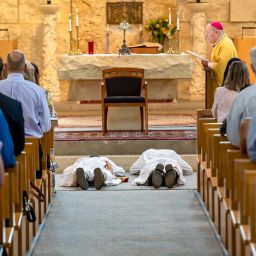By Father John Bayer, O. Cist.
Special to The Texas Catholic
One of the most important rooms in a monastery, after the church, is the chapter room. This is the place where monks meet to do various things as a community: hear an exhortation from their abbot; listen to a spiritual reading (often a chapter from “The Rule of St. Benedict”); deliberate and vote on the important material and spiritual questions that arise in a monastery, such as who should be the abbot, whether to welcome a young monk as a permanent member of the community through solemn profession, and how best to structure their lives to promote God’s purpose.
A chapter room offers several lessons about community life, which I think we all would do well to learn.
First, all the chapter rooms I have seen have a lesson just in their architecture: The seats are placed in a circle or square, such that all the monks can see each other, as opposed to having all the seats face the same direction (i.e., toward the presider) like in a lecture hall. In a monastery, conversations should be authentically communal. The monks are not just debating ideas; they are cultivating relationships and caring for each other as members of a body, and so they look at each other when they speak.
So, the first lesson I’d like to draw is that debate should always be between people who see each other as members of a shared body. Contrast the monks facing each other in a chapter room to the people filling digital spaces with thoughtless, drive-by diatribes, or to journalists and pundits citing rumor and anonymous sources that simply sow confusion and anger, or to politicians talking past each other to grandstand before their real audiences elsewhere. People are harder to caricature and scapegoat when we look them in the eye and commit to loving them as members of our own body. Our world could use a few more chapter rooms!
Second, a chapter room is hierarchically arranged. An abbot is not an autocrat, but he is a chief executive. So, his position is prominent, even as it is within the circle or square of the chapter room. St. Benedict describes the relation between head and members in a monastic community in various places in “The Rule of St. Benedict,” but one of my favorites is “Chapter 3: Summoning the Brothers for Counsel” — this is the section about community meetings, and thus it explains what should happen in a chapter room.
The first exhortation in this section is simply to hold community meetings. But how often? “As often as anything important is to be done” (RB 3:1). Communication is essential to community life, and it should not be neglected, even if it sometimes takes great patience.
The second exhortation is that the abbot should call “the whole community” to the meeting. Everyone is to be given a chance to speak his mind, since “the Lord often reveals what is better to the younger” (RB 3:3). A good leader is ready to listen to everything said to him in good faith. But St. Benedict wisely also notes that the monks, “for their part, are to express their opinions with all humility and not presume to defend their own views obstinately.” They should say their piece, but then they should humbly defer. For, “The decision is rather the abbot’s to make, so that when he has determined what is more prudent, all may obey” (RB 3:4-5). Humility on both sides allows for the greatest communication and counsel. If the monks are free to speak without fear of being cowed into silence by an imperious authority, then the abbot will have access to everything the community knows. And if the abbot is free to listen without fear that his rightful authority will be undermined by prideful monks who refuse to relativize their own opinions and trust in God, then all the monks will be able to share responsibility for their common life.
What can we do to create more chapter rooms in our world? That is, how can we each help our religious and civic spaces become ever better places for people to speak to each other truthfully and as committed members of a body acting together for the good? How can we all promote sincere communication and support our leaders through frank advice and rightful deference? We all have a role to play in ensuring that we speak to each other with solidarity in our homes, neighborhoods, and institutions.
Father John Bayer, O. Cist., is a monk at the Cistercian Abbey of Our Lady of Dallas in Irving.
Cutline for featured image: Cistercian Monks at Our Lady of Dallas Cistercian Abbey in Irving gather as a community in their chapter room.















